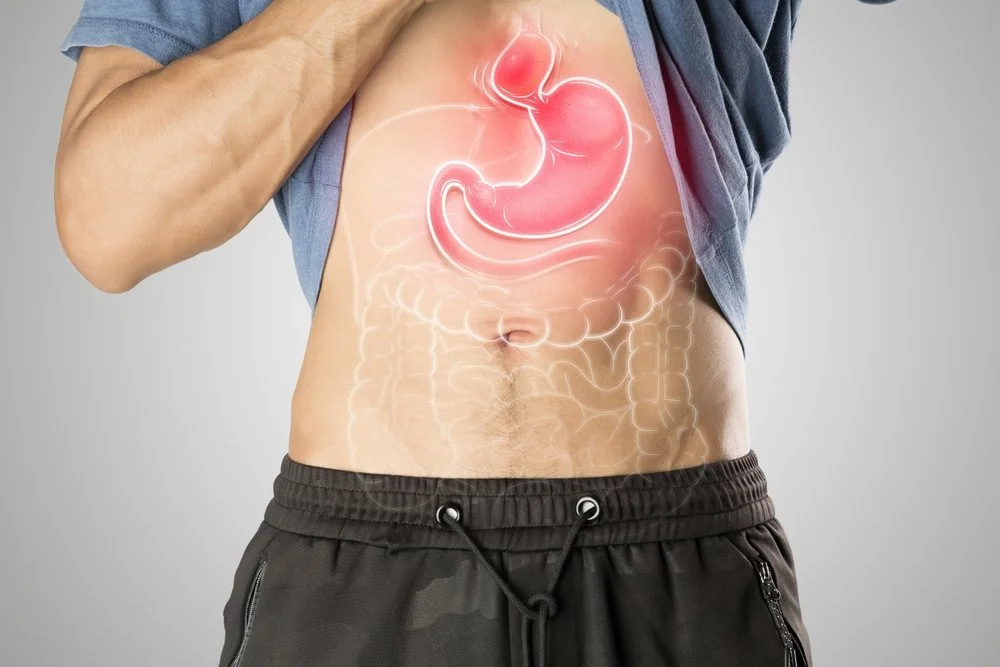Hiatal Hernias: A Functional Medicine Approach to Natural Relief
Understanding Hiatal Hernias
A hiatal hernia occurs when part of your stomach pushes upward through your diaphragm. The diaphragm is the dome-shaped muscle that separates your chest from your abdomen. Normally, your esophagus passes through a small opening in this muscle called the hiatus. When your stomach squeezes through this opening, it creates a hiatal hernia.
This condition is surprisingly common. Studies show that 55-60% of people over age 50 have a hiatal hernia, though only about 9% experience noticeable symptoms. The most recognised symptom is acid reflux, which happens because the hernia disrupts the lower esophageal sphincter (LES)—the valve that normally keeps stomach contents from flowing backward into your esophagus.
Most cases (around 95%) are sliding hiatal hernias, where the junction between the esophagus and stomach slides upward into the chest and may move back and forth. Less common types, called rolling or paraesophageal hernias, involve part of the stomach bulging through beside the esophagus.
Beyond Heartburn: Hiatal Hernia Syndrome
Conventional medicine typically associates hiatal hernias only with digestive symptoms, such as heartburn and regurgitation. However, functional medicine practitioners recognise a much broader pattern of symptoms, often called "Hiatal Hernia Syndrome."
Many people with hiatal hernias experience:
Respiratory issues: Shortness of breath or difficulty taking deep breaths
Cardiac symptoms: Heart palpitations or chest pressure
Psychological effects: Anxiety or panic attacks
Digestive problems: Bloating, constipation, early fullness, or difficulty swallowing
Sleep disruption: Interrupted sleep or insomnia
Systemic issues: Fatigue and mental fog from poor nutrient absorption
Because these symptoms don't fit the typical GERD profile, many people remain undiagnosed or are told their issues are purely anxiety-related. This disconnect often leaves them searching for answers for years.
The Root Causes: A Functional Medicine Perspective
While conventional medicine identifies risk factors such as age, obesity, and physical strain, functional medicine delves deeper to understand why these hernias develop in the first place.
The Pressure Problem
The core driver of hiatal hernias is sustained upward pressure within your abdomen. This pressure doesn't come from nowhere—it's created by excess gas production in your digestive tract.
Here's how it happens: When bacterial overgrowth occurs in your stomach or small intestine (a condition called SIBO), these bacteria ferment undigested food, particularly carbohydrates. This fermentation produces large amounts of gas, including hydrogen, methane, hydrogen sulphide, and carbon dioxide. Studies show this process can generate up to 3 litres of CO₂ during digestion alone.
This gas creates measurable increases in abdominal pressure that physically push your stomach upward through the weakened hiatus. Once the hernia forms, it becomes self-perpetuating: the displaced anatomy prevents your LES from functioning properly, causing reflux regardless of your actual acid levels.
The Vicious Cycle
Many hiatal hernias develop through a troubling cascade that conventional treatment actually makes worse:
Low stomach acid allows bacteria to survive and proliferate (covered in detail elsewhere in our Low Stomach Acid module)
Bacterial overgrowth ferments food, creating gas and pressure
Sustained pressure stretches the hiatus, allowing the stomach to herniate
The hernia compromises the LES, causing reflux symptoms
Acid-suppressing medications (PPIs) are prescribed, further reducing stomach acid
The cycle continues, often worsening over time
This explains why many people find that acid-blocking medications provide temporary symptom relief but don't solve the underlying problem—and may even make the root cause worse.
Vagus Nerve Dysfunction
Your vagus nerve plays a crucial role in digestive health. This long cranial nerve controls stomach acid secretion, gastric motility, and the tone of both your LES and diaphragm.
When vagal function is poor—often due to chronic stress, inflammation, or gut dysbiosis—digestion slows down dramatically. Food sits longer in your stomach, promoting fermentation and the production of gas. Additionally, a weak vagus nerve creates a "loose and floppy" LES that can't effectively prevent reflux.
This combination of slow motility and a weak sphincter creates ideal conditions for hernia formation.
Tissue Weakness
Research indicates that individuals with hiatal hernias exhibit an altered collagen composition in the ligaments that anchor the esophagus to the diaphragm. One study found that the collagen content was approximately 60% lower in patients with hiatal hernia compared to healthy controls.
This tissue weakness can result from:
Chronic catabolic states: When your body breaks down tissue faster than it can rebuild it (often due to chronic stress or poor sleep)
Nutrient deficiencies: Particularly vitamins C and zinc, which are essential for collagen production
Connective tissue disorders: Such as Ehlers-Danlos syndrome
Aging: Natural decline in tissue repair mechanisms
Non-Surgical Treatment Approaches
Functional medicine offers a comprehensive toolkit for addressing hiatal hernias by tackling their root causes. While surgery remains an option for severe cases, many people find significant relief through natural interventions.
Manual Therapies
These hands-on techniques aim to physically reposition your stomach back below the diaphragm.
Self-Adjustment Technique (Water-Drop Method):
First thing in the morning (before eating), drink 1-2 glasses of warm water quickly
Stand up straight
Rise onto your tiptoes
Drop suddenly back to your heels, creating a jarring motion
Repeat 10-15 times
The warm water adds weight to your stomach while relaxing your diaphragm. The sudden drop uses gravity to pull the stomach back down. Many practitioners report improvements in reflux, bloating, and post-meal discomfort within one week of daily practice.
Professional Manual Therapies:
Osteopathic Manipulative Treatment (OMT): Studies show OMT can significantly improve GERD symptoms and increase LES pressure by 9-27%. One documented case showed complete anatomical correction of a hiatal hernia after just four OMT sessions.
Chiropractic Adjustment: Chiropractors trained in specific techniques for hiatal hernia use gentle adjustments to guide the stomach back into its proper position.
Myofascial Release: This therapy targets the tight fascia surrounding your diaphragm and abdomen. A randomised controlled trial found that two myofascial release treatments per week for two weeks improved GERD symptoms and reduced the need for acid-blocking medications.
Diaphragmatic Breathing
Breathing exercises strengthen your diaphragm and enhance its function as a barrier against reflux.
Basic Technique:
Lie down or sit comfortably
Place one hand on your chest, one on your belly
Breathe in deeply through your nose, focusing on expanding your belly (not your chest)
Exhale slowly through pursed lips
Practice 10 repetitions, multiple times daily
Research demonstrates that diaphragmatic breathing training significantly improves GERD symptoms and strengthens the entire anti-reflux mechanism. The technique increases diaphragm muscle tone, improves esophageal clearance, and helps break the pattern of shallow chest breathing.
Addressing Bacterial Overgrowth
Since excess gas from bacterial fermentation drives much of the pressure that creates hernias, treating bacterial overgrowth is crucial. While our website covers SIBO treatment in detail elsewhere, key strategies include:
Antimicrobial protocols: Herbal and other natural antimicrobials (oregano oil, berberine, D-limonene). Antibiotics should only be used as a last resort, as they can disrupt the gut’s essential microbiome.
Low FODMAP diet: Reduces fermentable substrates that feed problematic bacteria
Breath testing: To confirm successful eradication
Probiotics & Prebiotics: After clearing overgrowth, to restore healthy gut balance
Studies show that when SIBO is successfully treated, both gas production and reflux symptoms decrease significantly.
Supporting Vagus Nerve Function
Improving vagal tone enhances digestion and reduces the conditions that promote hernias:
Deep breathing exercises: Slow, diaphragmatic breathing activates the vagus nerve
Cold water exposure: Brief cold showers or face splashing
Humming or singing: The vibrations stimulate vagal pathways
Meditation: Regular practice improves vagal tone over time
Reducing inflammation: Addressing gut inflammation that irritates the nerves
Tissue Repair Support
Since weakened connective tissue contributes to hernia formation, supporting collagen synthesis is important:
Vitamin C: Essential for collagen production
Zinc carnosine: Needed for tissue repair (and stomach acid production)
Hydrolysed collagen: Provides amino acids for tissue building
Adequate protein: The building blocks for all tissue repair
Magnesium: Supports numerous repair processes
Additionally, addressing chronic stress through proper sleep, stress management, and balancing cortisol levels helps shift your body from a catabolic (tissue breakdown) state to an anabolic (tissue building) state.
Lifestyle Modifications
These foundational strategies support all other interventions:
Eating patterns: Smaller, more frequent meals; avoid food 3-4 hours before bed
Positioning: Elevate the head of your bed 6-8 inches (use blocks under bedposts); stay upright after eating
Weight management: Reducing excess abdominal weight decreases pressure
Clothing: Avoid tight belts or clothing around your abdomen
Posture: Work on correcting a forward-hunched posture that compresses your abdomen
Trigger foods: Eliminate caffeine, alcohol, chocolate, peppermint, fatty foods, and citrus if they worsen symptoms
When Surgery May Be Necessary
While functional medicine approaches can provide significant relief for many people, surgery remains an important option for severe cases. Laparoscopic Nissen fundoplication, where the top of the stomach is wrapped around the lower esophagus to reinforce the LES, has success rates exceeding 95% with modern techniques.
Surgery may be warranted for:
Large or paraesophageal hernias (Type 2-4)
Severe symptoms that don't respond to conservative treatment
Complications like bleeding, obstruction, or strangulation
Quality of life was significantly impacted despite treatment
However, even after successful surgery, addressing the underlying causes—particularly bacterial overgrowth, low stomach acid, and chronic pressure—helps prevent recurrence.
The Integrative Path Forward
The functional medicine approach to hiatal hernias differs fundamentally from conventional treatment. Rather than simply suppressing symptoms with acid-blocking medications, this approach aims to understand and address the underlying cause of the hernia.
The most successful outcomes occur when multiple interventions are combined:
Manual techniques to physically reposition anatomy
Breathing exercises to strengthen the diaphragm
Treatment of bacterial overgrowth to reduce gas pressure
Support for vagus nerve function
Nutritional strategies to rebuild tissue strength
Lifestyle modifications to reduce ongoing strain
This comprehensive approach requires commitment and consistency. Changes don't happen overnight. Most people need several weeks to months of dedicated practice to see significant improvement. However, by addressing root causes rather than just masking symptoms, functional medicine offers a pathway to lasting relief—one that treats you as a whole person rather than simply suppressing your body's warning signals.
If you're experiencing symptoms of a hiatal hernia, consider working with a functional medicine practitioner who can help you navigate this integrative approach and customise treatments to your specific situation. While the journey may require patience, many people find that addressing the underlying causes provides not only symptom relief but also improved overall health and vitality.




